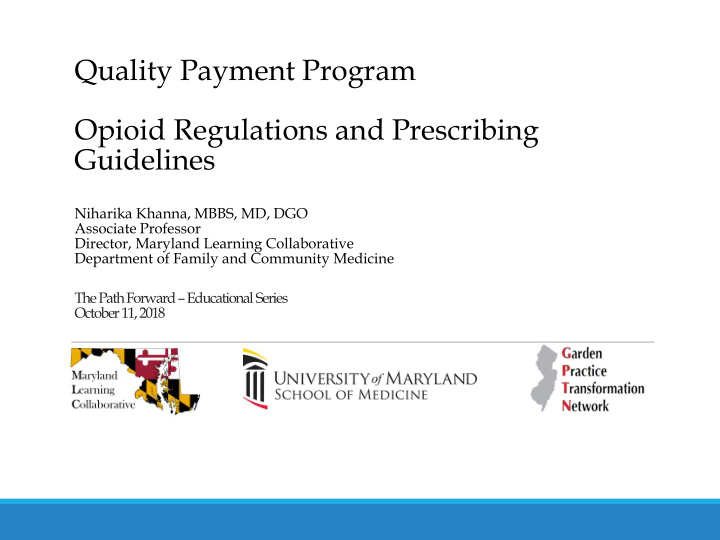



Quality Payment Program Opioid Regulations and Prescribing Guidelines Niharika Khanna, MBBS, MD, DGO Associate Professor Director, Maryland Learning Collaborative Department of Family and Community Medicine The Path Forward – Educational Series October 11, 2018
Chronic Pain and Prescription Opioids • 11% of Americans experience daily (chronic) pain • Opioids frequently prescribed for chronic pain • Primary care providers commonly treat chronic, non-cancer pain – account for ~50% of opioid pain medications dispensed – report concern about opioids and insufficient training
Sharp Increase in Opioid Prescriptions Increase in Deaths
Risk of opioid-related overdose increases with daily use
Guideline for Prescribing Opioids for Chronic Pain
Purpose, Use, and Primary Audience • Primary Care Providers – Family medicine, Internal medicine – Physicians, nurse practitioners, physician assistants • Treating patients >18 years with chronic pain – Pain longer than 3 months or past time of normal tissue healing • Outpatient settings • Does not include active cancer treatment, palliative care, and end-of-life care
Organization of Guidelines • The 12 guidelines are grouped into three conceptual areas: – Determining when to initiate or continue opioids for chronic pain – Opioid selection, dosage, duration, follow-up, and discontinuation – Assessing risk and addressing harms of opioid use
CDC Guidelines for Prescribing Opioids for Chronic Pain 1. Nonpharmacologic therapy and nonopioid pharmacologic therapy are first line. 2. Establish expectations. Before starting opioid therapy: establish realistic treatment goals; and determine when therapy will be stopped. 3. Address risks/benefits with patients. Before starting and periodically during opioid therapy risks and benefits should discussed. 4. Use the lowest effective dose. 5. Shortest duration. Use opioids for a short duration if possible. 6. Acute Pain. If treating acute pain with opioids: Use lowest effective dose of immediate-release opioids; limit quantity, 3 days is usually sufficient; and more than 7 days rarely needed.
Relationship of prescribed opioid dose (MME) and overdose
CDC Guidelines for Prescribing Opioids for Chronic Pain 7. Re-evaluate. Evaluate benefit and harm within one to four weeks of starting or dose escalation, and at least every three months. 8. Reduce risk. Avoid prescribing for high risk patients, and prescribe naloxone when overdose risk factors are present. 9. Check the Prescription Drug Monitoring Program at least annually and during use of an opioid therapy. 10. Use urine drug testing at least annually and before starting any new opioid therapy. 11. Avoid benzodiazepines. Avoid prescribing concurrently with opioids. 12. Opioid Use Disorder Treatment. Evaluate your patients for opioid use disorder and arrange for evidence-based treatment when needed.
Maryland Medicaid Policy Prior Authorization for Opioids Prior Authorization Required Every 6 Months for: • High dose >90 MME, or • High quantity*, or • Long Acting Opioids, Fentanyl, or Methadone for pain *A standard 30-day quantity limit for all opioids – even if the MME/day is ≤90.
Naloxone
Thank You Comments and Questions! Presentation adapted from CDC and Maryland Department of Health resources 14
Recommend
More recommend